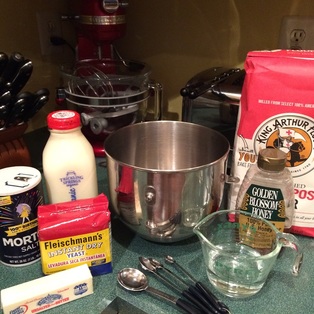 You will need the following ingredients: 4 Cups - Unbleached, All-Purpose Flour 1 Cup - Whole, Organic Milk ½ Cup - Water 1 Tblsp - Instant DRY Yeast 6 Tblsp - Unsalted Butter, Softened 2-4 Tblsp - Honey 2 Tsp - Salt DIRECTIONS Whisk together the flour and yeast in the mixer bowl. The flour and yeast should be thoroughly mixed, so whisk briskly for at least a minute. Combine the whole milk and water in a 2-cup capacity, microwavable measuring cup, and microwave the milk/water until it is approximately 105°F (40-60 seconds on ‘High,’ depending on your microwave). Use a food thermometer after removing the measuring cup from the microwave to ensure precise temperature. If it’s not hot enough, place the milk/water back in the microwave (without the thermometer, of course), and heat incrementally until 105°F is reached. If the milk/water is too hot, simply leave it to cool to 105°F. The proper temperature is important, because the dough needs to be warm enough to allow the yeast to bud, and the dough to rise. If the solution is too hot, you’ll kill the yeast. Too cold, and the yeast won’t do anything. Place the mixer bowl on your stand mixer and mix at low speed with a dough hook. On a KitchenAid mixer, this would be speed #2. Add the butter in 1 tablespoon increments, then slowly add the heated milk/water mixture, followed by the honey, then the salt. (Note: You’ll have 2 tablespoons of butter left over from your stick. Place the remainder in the refrigerator for the time being, as you will use it later.) Use a bowl scraper to scrape the sides of the mixing bowl if necessary, while adding the ingredients. I prefer one with a handle, only because it’s easier to use. Once all the flour is moistened, increase your mixer to medium speed (#4 on a KitchenAid), and beat for 7 minutes. 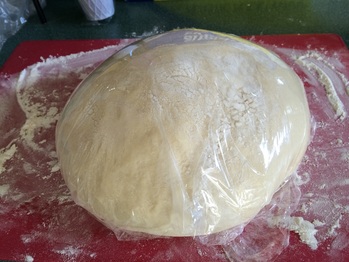 At the end of the 7 minutes, remove the dough from the mixer, and place it on a lightly floured countertop (I also use a silicone food mat). The dough should be smooth and somewhat shiny. Knead the dough by hand for a minute or two, shaping it roughly into a football. Then cover it with plastic food wrap and let it rest for 15 minutes. The dough should approximately double in size during that time if the yeast is properly active. Remove the plastic food wrap from the dough and knead by hand for another couple of minutes, gradually working it into an elongated shape for easy placement into the pain de mie pan.  Insert the dough into a pain de mie pan that has been greased on all sides with unsalted butter, using the remainder of the stick you had placed in the refrigerator. Note: Using butter on the sides of the bread pan allows the bread to brown nicely when placed in the oven. Depress the dough with your knuckles or fists so that it uniformly covers the entire bottom of the bread pan. Slide the lid on the pain de mie pan, leaving about an inch opening at the end, covering that opening with plastic food wrap. Don’t forget to also grease the underside of the lid with your remaining unsalted butter. 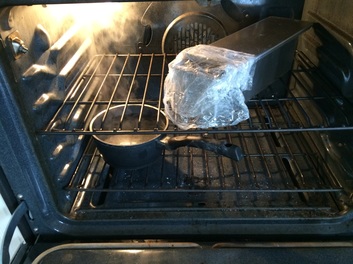 If you are not using a proof box, you can use your oven for the second dough rise. Place the bread pan on the center rack of an unheated oven to allow the dough to proof (e.g., rise) for 30-40 minutes. I also pre-boil a pot of water, and place the pot of boiling water on the bottom of the oven when I place the dough in the oven to proof. The moisture and heat from the boiling water helps the dough to rise faster. When you see the dough coming up through the 1-inch opening you left at the end of the bread pan, remove the pan from the oven, and the lid from the pan. Deflate the dough with your knuckles or fists, then slide the lid fully back on the pain de mie pan. Preheat the oven to 425°F, placing the bread pan on the center rack for 20 minutes. Make sure that the position of the pain de mie pan is such that the lid slides towards you when you place it in the oven. At the end of 20 minutes, open the oven door and carefully slide the lid of the pain de mie pan completely off, placing the lid in your sink or other safe place. I use silicone potholders for this operation. Remember, you’re handling metal that is 425°F. Leave the bread pan baking in the oven without the lid for another 8-15 minutes – depending on how brown and thick you want your crust. When the bread has browned to your desired level, remove the bread pan from the oven, and let sit for 5 minutes. The bread will shrink slightly during that time, allowing you to easily remove it from the pan. 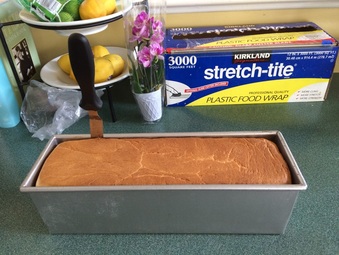 After the 5-minute cooling period, I gently run a small icing spatula around the perimeter the bread (but you can also use a standard butter knife). Spread a clean kitchen towel on your counter and, using potholders (as your bread pan will still be extremely hot), pick the bread pan up by the ends and slowly tilt the pan away from you, directly over the kitchen towel. The bread should simply tumble out of the pan onto the towel. Place the bread on a cooling rack for at least 30 minutes before slicing. The first slice is always the best! 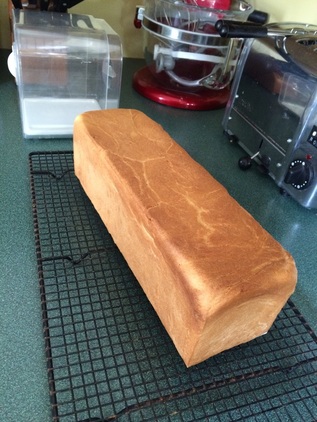 Required Equipment Probably the most critical item you’ll need to bake a standard Pullman loaf is the bread pan. I use Amco Food Service Pullman Pans with sliding Lids, and I find them to be the best bread pans I’ve ever used. They’re heavy-gauge, aluminized steel, commercial bakery pans. And perhaps most important of all, they have a silicone coating that allows the bread to simply slide out, and clean-up is a snap – ‘cause nothing sticks. These pans are available from Amazon. Just click on the links above to see them. A standard dial pocket food thermometer is what I use to ensure my milk/water mixture is at 105°F. Not sure how you can achieve that without one. You can get these for about $5. A 2-cup capacity Pyrex glass liquid measuring cup is also virtually essential to get your milk/water mixture to the proper temperature using a microwave. About $7-$9. Standard sets of dry measuring cups and measuring spoons are probably also essential. Some bakers are experienced enough to gauge by dead reckoning. But I know I’m not. You actually don’t need an electric stand mixer with a dough hook in order to make your dough. Indeed, people have been kneading dough by hand for millennia. You can mix the ingredients manually in a bowl until the dough reaches a consistency where you can take it out and knead it by hand. But figure on allowing yourself at least an extra 20 minutes to do that. Good exercise, though. If you do use an electric mixer, make sure it has a powerful enough motor to handle the density of the dough. My choice would be a standard KitchenAid, but you’ll need a fair amount of dough to get one (sorry). And So Why Is It Called a Pullman Loaf? Pullman loaves were originally called pain de mie by the French, and were baked by European bakers beginning in the early 1700’s in order to minimize crust. In the United States, the Pullman Company selected this type of loaf for standard use in all of its railroad dining cars, simply because its brick shape made it stackable, and it conserved space in the very compact dining car galleys and pantries operated by Pullman. Given that most people alive today only know of Amtrak as an operator of rail passenger service in the United States, few probably realize that up until December 31, 1968 – the Pullman Company operated virtually all sleeping car service in the country, and at its peak in 1925, operated a fleet of 9800 cars, employing 28,000 conductors and 12,000 porters. Observation-lounge bar car Hickory Creek operated on the New York Central's 20th Century Limited between New York and Chicago from 1948 until the mid-1960's. The car also had 5 double bedrooms. The on-board services, amenities and equipment offered by the Pullman Company were considered to be so superior, that virtually all famous trains operated during the last century, such as the Pennsylvania Railroad's Broadway Limited, and the New York Central's 20th Century Limited were operated for most of their existence as extra-fare, all-Pullman trains - meaning that all the railroads did was to pull the cars that were actually operated by another company - not the railroads themselves.
I sometimes wonder how many Americans today even know what a Pullman car is. Yet as recently as only 50 years ago, they were as much common-knowledge as Western Union telegrams. The company was headquartered on the South Side of Chicago. When company founder George Pullman died in 1897, Robert Todd Lincoln, son of Abraham Lincoln, was named as company president. In 1911, he was named chairman of the board of the Pullman Company, and remained in that position until 1922. He died in 1926. So there you go. More information about Pullman loaves than you could ever possibly imagine. Enjoy the bread! © 2016 David Nogar All Rights Reserved
3 Comments
Note: If viewing Part 4 on an iPad or other tablet, this particular post is best viewed in a landscape orientation due to some formatting issues specific to the mobile environment. Smart phones are fine in portrait mode. Finally, those of you following this blog for its lifestyle perspectives may be wondering about the purpose of all of these initial, perhaps overly philosophical postings, and why this one in particular addresses a topic that could be considered by many as so morose. Because we all have to deal with it.
How we react to the hurt can have enormous consequences regarding the quality and fulfillment of our lives. And so I felt that it was important to establish some basic tenets of Social Interaction, because I view it as such a key element in the pursuit of flânerie – which happens to be my adopted personal approach for maximizing the quality of my remaining life, and which I have also chosen to share with others through this blog. All too often I find that the people with whom I interact are struggling with the same issues that I am - but nobody seems to want to discuss them openly. Instead, most prefer to construct facades of perfection in their lives for the benefit of others that have no relationship to reality. As a result, their struggles are unaddressed, and therefore unresolved. And the hidden despair and loneliness simply continues, albeit perhaps somewhat repressed. And of course with the advent of the Internet and social networking sites such as Facebook, we've all taken the perpetuation of 'happy face' facades to a whole new globalized level, haven't we? So with this posting, along with all of the other previous material that has been uploaded onto The American Flâneur blog and website, I think we’ve essentially established an important prerequisite framework with which to start truly enjoying what this life has to offer, face-to-face with our fellow human beings, along with some approaches to handle the pitfalls we're definitely going to encounter along the way. So, here we go. It's time to kick-ass and make the most out of life. © 2016 David Nogar All Rights Reserved I must give my profound thanks to a cherished friend and award-winning blogger, Ms. Lisa M. Barr, who reviewed the preliminary draft of what became this 4-part post, and who was kind enough to provide her insightful comments regarding this difficult topic and my treatment of it - although I'm positive I didn't follow anywhere near enough of her very sage advice. Ms. Barr is just a wonderful lifestyle and bridal writer and blogger, and you can follow her on a number of her own social networking sites, a couple of which can be accessed by clicking on the icons below.
Now as much as it pains me to say this – as it is by now quite apparent that I am an enthusiastic advocate of quality bars as social institutions, particularly in the pursuit of flânerie – one thing I would not do when you’re hurting, is to go to your local bar and drown your sorrows in a half dozen or so cocktails, crying on the shoulder of your favorite bartender.
But perhaps more importantly, the consumption of alcohol does not ameliorate the effects of the melancholy. In fact, if you’re drinking by yourself, it only makes it worse. So if you’re sad when you walk into the bar, you’ll no doubt be about ready to kill yourself by the time you have to leave (especially after you get the bar tab).
I truly believe the best bet is to follow the points summarized in Part 2, to pray (yes, that's right, pray), and to just keep moving forward in terms of continued constructive Social Interaction. And that would be my best (and really only) advice to anyone, when the doors of friendship and love slam shut. You really have very little, if any, control over the feelings or perceptions of others. When you're rejected or betrayed by someone dear, it goes to the very core of your self-worth. It can cripple you if you let it. I get that. But you really need to suck it up and keep moving on. And that's what this series of postings is intended to help you do. So let's wrap all of this up in Part 4. © 2016 David Nogar All Rights Reserved Note: If viewing Part 2 on an iPad or other tablet, this particular post is best viewed in a landscape orientation due to some formatting issues specific to the mobile environment. Smart phones are fine in portrait mode. So, continuing from Part 1 of this post, when a door slams shut in my life with someone who had previously added so much to the quality of it, here are some things I hope that I will have the ability to do, in terms of strength, awareness and self-discipline, and I would respectfully suggest, you should too:

We'll continue to talk about the recovery process, including what not to do, and how to proceed next, in Part 3 and a few other subsequent blog postings. © 2016 David Nogar All Rights Reserved “Then Peter came to Jesus and asked, ‘Lord, how many times shall I forgive my brother when he sins against me? Up to seven times?’ Jesus answered, ‘I tell you, not seven times, but seventy times seven times.'" Matthew18:21-22 We talked at length in the last post about how that with some of those whom you meet during your lifestyle as a flâneur, you will develop a profound admiration, affection and perhaps even love. This is a good thing. It is one of the most meaningful things you can do with your life, and it is one of the primary reasons for leading the life of a flâneur – so that you can meet as many such people as practicable. They will enrich and add meaning to your life. It is why Social Interaction is so important.  But there will be those who will not return your admiration or affection. At best they might be indifferent. Or they may even actively dislike you, ridicule you, or exploit your affections and maybe even play you for a fool by attempting to take advantage of you. Some may even betray your trust. Or even try to strategically harm you – in your work environment or your social or personal life for their own perceived advantage. When this happens, there will be a hurt and a bitterness unlike just about anything you’ve otherwise experienced. This is one of the reasons why I placed such an emphasis on Agape love in the last post. Love selflessly. Expect nothing in return. In doing so, you’re laying the emotional groundwork for dealing with the intense pain of rejection or betrayal when, (not if), it ultimately comes – without letting it ruin your life by poisoning your attitude or outlook. Because if you let that happen, you’re likely no longer to engage constructively in meaningful Social Interaction, which is so critical in my opinion to successful flânerie, and in enriching the quality of your life. I can frankly see such rejections or betrayals coming in my own life, as sure as I am writing these words. And I am preparing for the blows when they come, because they will be devastating and profound, particularly at my age and stage of life. But whether you see it coming, or whether it catches you completely off-guard, what do you do when it happens? We'll talk about that a bit in Part 2. © 2016 David Nogar All Rights Reserved |
Author
David Nogar worked in railroad operations for almost 50 years until retiring from the transportation business in early 2023.
|
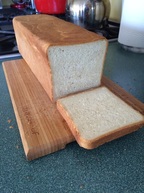


 RSS Feed
RSS Feed